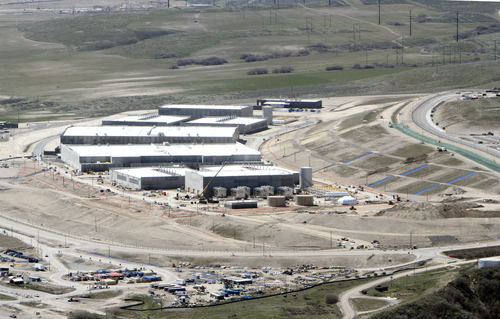This is an archived article that was published on sltrib.com in 2013, and information in the article may be outdated. It is provided only for personal research purposes and may not be reprinted.
If you want a clue as to whether there are problems at the Utah Data Center, talk to the man selling the massive spy building its water.
When operational, the Utah Data Center is expected to consume 1.7 million gallons a day in order to cool the people and technology inside. But so far, says Bluffdale City Manager Mark Reid, water consumption has been wildly inconsistent.
"They've gone from no usage to over their amounts that they planned to use," Reid said on Tuesday.
"I don't know what they're doing there," Reid said, "but they're usage has been all over the board. "
The sporadic water use could point to the kinds of equipment failures reported this week in the Wall Street Journal. The newspaper said the Utah Data Center has been plagued by power surges that have ruined "hundreds of thousands of dollars worth of machinery" and "delayed the center's opening for a year."
The newspaper reported there is not yet a consensus on how to fix the electrical failures. The Journal said there have been 10 failures — the first on August 2012 and most recently on Sept. 25.
The U.S. Army Corp of Engineers office in Sacramento, Calif., has been the lead engineer on the project since construction. On Tuesday, a spokeswoman in that office, DeDe Cordell, released a written statement confirming much of The Journal report.
"During the testing and commissioning of the Utah Data Center, problems were discovered with certain parts of the electrical system," the statement said. "Issues such as these can arise in any project, and are the reason the Corps tests and reviews every aspect of any project prior to releasing it to the customer.
"Because of the scope of this project, a specialized team of experts from the Corps' headquarters was sent to review and assist with addressing these issues. The cause of the electrical issues was identified by the team and is currently being corrected by the contractor. The final commissioning of the entire electrical system is still ongoing. The Corps is ensuring it functions as required and that it will be completely reliable prior to releasing the project to the customer."
The statement from the Corps of Engineers added that there are no issues with computers controlling the electrical systems.
The Utah Data Center was scheduled to be operational last month or this month — the NSA would not specify — and employ about 200 people.
While the Department of Defense contracted with a state agency to build substations and utilities outside the Utah Data Center, the massive building itself and everything occurring inside has been overseen by the Corps of Engineers and the Defense Department.
Cordell said she could not provide the documents reviewed by The Journal and that the Corps of Engineers would be "interested to know" how the Journal acquired or reviewed them. NSA spokeswoman Vanee Vines said in an email that "testing is underway" at the Utah Data Center.
The 1 million-square-foot data center will use 65 megawatts of electricity (a single megawatt is enough to run appliances in 500 to 750 homes). Rocky Mountain Power's largest Utah customer is Kennecott Utah Copper, which uses about 200 megawatts.
While cheap electricity was a major factor in why the NSA placed a data center in Utah, available water also was an issue. The NSA has an agreement to purchase water from Bluffdale. Bluffdale receives waste water from the Utah Data Center and uses it to water city parks.
Reid did not immediately provide statistics on the Utah Data Center's water usage. The NSA has agreed to buy a set amount of water from Bluffdale even if the Utah Data Center doesn't use it all. That's to ensure Bluffale is able to repay a $3.5 million bond it issued in 2011 to pipe the water to the data center.
— Matt Piper contributed to this report.
Twitter: @natecarlisle



